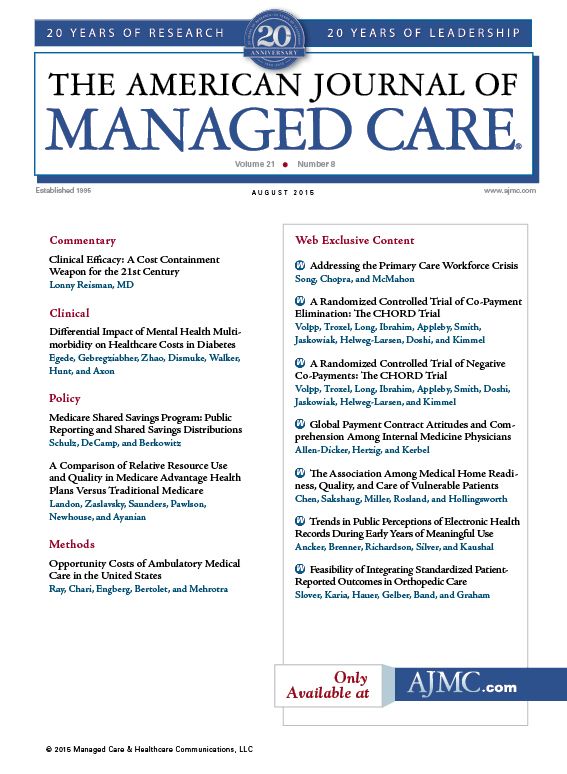- Center on Health Equity & Access
- Clinical
- Health Care Cost
- Health Care Delivery
- Insurance
- Policy
- Technology
- Value-Based Care
Clinical Efficacy: A Cost Containment Weapon for the 21st Century
Mitigating cost increases through preemptive care and clinical efficacy to reduce the disease burden of clinically at-risk patients.
Unrelenting increases in medical spending persist despite a variety of approaches designed to drive greater efficiencies in healthcare delivery. Rather than limiting our focus to the efficient management of cost and utilization in patients with advanced and irreversible disease, perhaps our attention should be redirected to an earlier point in the disease continuum. Specifically, to a moment along that continuum that allows us to address the clinically efficacious management of high-risk patients who are likely to manifest reversible physiologic signals in advance of permanent complications. Effectively, would it be preferable to detect and optimize the clinical management of a patient exhibiting risks of a stroke, for instance, in order to preempt that eventuality, rather than engaging after the stroke in the efficient management of bed days, discounts, and long-term care costs? The answer is obvious, and so is the reality that without reducing avoidable complications associated with chronic disease—the costs of which account for 80% of medical expenses—the inevitable and highly desirable emergence of innovative drugs and de-vices that treat the severely ill will drive costs upward and overwhelm efforts centered around improved efficiency. To date, solutions focused on clinical efficacy have been overlooked given the complexity of patient monitoring and analysis, alignment of the care delivery system and its suppliers, and patient engagement factors.
The emerging bio-monitoring and health information technology sectors need to coalesce and transcend their current roles in data digitization and revenue cycle management. Prioritization should be placed on patient-specific data aggregation and analytics that summon evidence-based protocols that are particular to a patient’s biological circumstance at a particular moment in time, when patient characteristics and the best medical evidence may be at variance. We should be astonished, if not appalled, by the reality that our refrigerators can detect an empty container of milk and communicate with a home delivery grocer so as to not disappoint us at milk and cookie time, while a human body depleted of potassium has no way to communicate its deficiency in advance of a lethal cardiac arrhythmia.
Clinical efficacy driven by sophisticated analytics will undoubtedly save lives and limit costly avoidable complications associated with chronic disease, but at what alternative cost given the high expense associated with modern diagnostic and therapeutic options? To embark on a journey centered on medical excellence, delivery systems and suppliers of diagnostic services, devices, and pharmaceuticals will need to participate in health ecosystems with value/risk-based contracts that reward superior clinical and financial results. Some delivery systems are already engaged in accountable care risk contracts, but lower medical costs and improved clinical outcomes cannot be achieved if the tools necessary for clinical optimization are too costly and overwhelm the savings associated with disease avoidance. The recruitment of device and pharmaceutical companies to enter into disease-specific value-based contracts will be imperative in mitigating cost overruns in a model centered on clinical efficacy. In exchange for discounts granted to health ecosystems, manufacturers can expect higher volumes resulting from digital queries seeking out suitable patients for their products. In addition, manufacturers can participate in savings derived from their products’ contribution to improved clinical and financial results.
The fundamental role of patients in this model cannot be overstated, as a lack of engagement in supporting bio-monitoring, adherence to necessary therapeutic interventions, and lifestyle essentials will undermine the approach. In much the same way that we have relied too heavily on efficiency measures in lowering costs in established disease, rather than being preemptive, we have relied too heavily on patient discretion and elasticity of demand in developing plan designs that put patient “skin in the game.” For low-value services, this approach makes sense, but in situations where medical evidence supports the preemptive nature of an intervention, demand should be rendered entirely inelastic and any financial barriers to access should be removed. The failure of current plan designs to accommodate the value of particular interventions for particular individuals in an emerging age of precision medicine needs to be addressed. Failure to do so will undermine the potential of digital solutions fueled by evidence-based care and financially aligned health delivery systems designed to optimize care and control costs.
Ultimately, the only way to sustainably mitigate cost increases is to mitigate the disease burden of clinically at-risk patients. Traditional wellness programs, while appealing, take too long to demonstrate a financial return; and case management programs, while valuable, are simply too late. Avoidable disease can and must be preempted through advanced digital solutions and aligned incentives. Otherwise, attempts at cost control will fail as an emerging burden of avoidable illness (eg, stroke, heart failure, end-stage renal disease, others) will be met by expensive new drugs, new devices, and long-term services, which will be valuable but never as impactful as the avoidance of these adverse outcomes.Author Affiliation: HealthReveal, New York, NY.
Source of Funding: None.
Author Disclosures: Dr Reisman reports no relationship or financial interest with any entity that would pose a conflict of interest with the subject matter of this article.
Authorship Information: Concept and design; drafting of the manuscript.
Address correspondence to: Lonny Reisman, MD, HealthReveal, New York, NY. E-mail: lreisman@healthreveal.com.

Trends in Hospital Pricing for Vulnerable Emergency Department Users, 2021-2023
December 4th 2025Self-pay emergency department prices rose significantly from 2021 to 2023, especially at for-profit and system-affiliated hospitals, highlighting growing affordability challenges for uninsured and underinsured patients.
Read More

